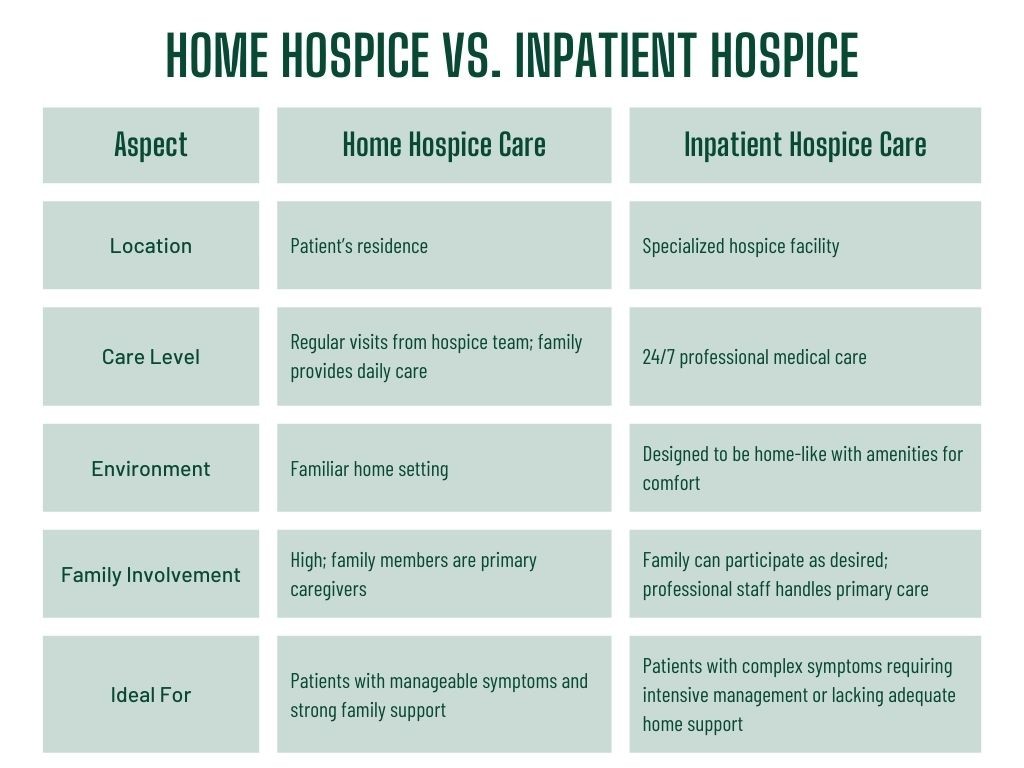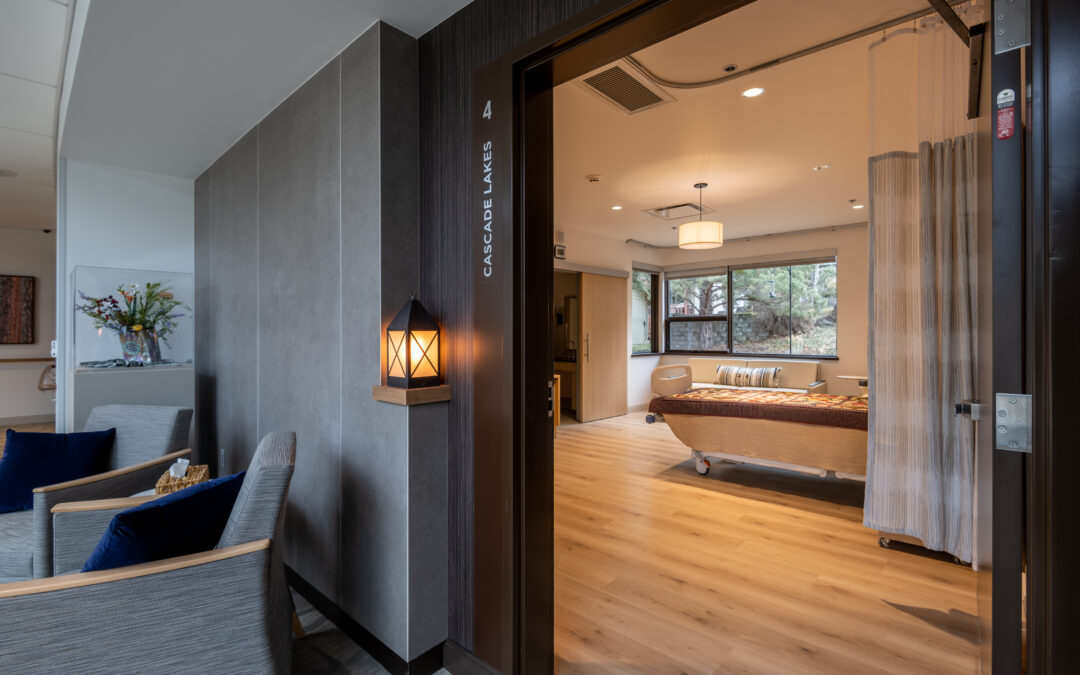Facing the end-of-life journey is a profound experience, both for individuals and their loved ones. Making informed decisions about the type of hospice care can significantly impact the quality of this journey. Understanding the distinctions between inpatient and outpatient hospice care is essential to ensure comfort, dignity, and peace during this time.
What is Hospice Care?
Hospice care is a compassionate approach designed to support individuals with terminal illnesses, focusing on comfort and symptom control rather than curative treatments. It addresses physical, emotional, and spiritual needs, aiming to enhance the quality of life in one’s final months. A dedicated team of healthcare professionals collaborates to provide personalized care tailored to the patient’s unique circumstances.
The Four Levels of Hospice Care
Hospice care is structured into four distinct levels to cater to varying patient needs:
- Routine Home Care: This is the most common level, where a terminally ill patient receives hospice services in their residence, be it a private home, assisted living, or nursing facility. The hospice team makes regular visits to manage symptoms and provide support.
- Continuous Home Care: For patients experiencing acute symptoms that require medication management, continuous care is provided in the home setting. This involves extended nursing services to stabilize the patient.
- General Inpatient Care: When symptoms cannot be effectively managed at home, patients are admitted to a facility—such as a hospice house or skilled nursing facility — for more comprehensive end-of-life care. The goal is to control symptoms so the patient can return home if possible.
- Respite Care: To provide caregivers with a temporary break, patients can be admitted to a facility for up to five days. This ensures the patient continues to receive professional care while caregivers rest and recharge.
Home Hospice Care (Outpatient Hospice)
In a home hospice program, patients remain in the comfort of their own homes, surrounded by familiar settings and loved ones. The hospice team, including nurses, social workers, and chaplains, visits regularly to manage symptoms, provide medical care, and offer emotional and spiritual support. Family members often play a significant role in daily caregiving, with the hospice team providing guidance and assistance as needed.
Inpatient Hospice Care
Inpatient hospice care is provided in specialized facilities like Partners In Care’s Hospice House in Bend, Oregon. Our facilities are designed to offer a serene, home-like environment where patients receive round-the-clock intensive care from medical professionals. A multidisciplinary team ensures comprehensive care, addressing complex symptoms that cannot be managed effectively at home. The Hospice House features private suites, family accommodations, and amenities such as gardens and meditation spaces to support both patients and their families.
When to Consider Home Hospice vs. Inpatient Hospice
Choosing between home and inpatient hospice care depends on several factors:
- Symptom Management: If a patient’s symptoms are well-controlled and manageable, home hospice allows them to stay in familiar surroundings. However, if symptoms become severe or unmanageable, inpatient care provides the necessary medical interventions.
- Caregiver Support: Home hospice relies on family members for daily care. If caregivers are available and willing, this can be a comforting option. In situations where caregiving is not feasible due to physical, emotional, or logistical reasons, inpatient care ensures the patient receives continuous professional support.
- Patient Preference: Honoring the patient’s wishes is paramount. Some may prefer the intimacy of home, while others might feel more secure with the immediate medical support available in an inpatient setting.
- Safety Considerations: If the home environment cannot accommodate necessary medical equipment or poses safety risks, an inpatient facility may be more appropriate.

At Partners In Care, we provide compassionate, patient-centered hospice care in Central Oregon that honors dignity, comfort, and quality of life. Our hospice services support individuals facing a life-limiting illness by focusing on pain management, emotional well-being, and spiritual care, allowing patients to spend their final months in peace—whether at home or in our Hospice House. Our interdisciplinary team, including physicians, nurses, social workers, chaplains, and trained volunteers, works closely with families to ensure each patient’s unique needs and wishes are met. We believe hospice is not just about medical care but also about providing emotional and spiritual support to both patients and their loved ones. At Partners In Care, we walk alongside families on this journey, offering guidance, comfort, and a community of care during life’s most profound moments.
Frequently Asked Questions
Q: Can a patient transition between home hospice and inpatient care?
A: Yes, patients can move between levels of care as their needs change. For instance, a patient receiving home hospice care may be admitted to an inpatient facility if symptoms become unmanageable at home and then return home once stabilized.
Q: Does insurance cover both types of hospice care?
A: Medicare, Medicaid, and most private insurance plans cover hospice care, including both home and inpatient services. It’s essential to review specific policy details to understand coverage and any potential out-of-pocket expenses.
Q: How do I know which option is best for my loved one?
A: Consider the hospice patient’s medical needs, personal preferences, the availability of family caregivers, and the home environment. Consulting with a hospice care team can provide valuable insights tailored to your situation.
Q: What services are provided at the Hospice House in Bend, Oregon?
A: Partners In Care’s Hospice House offers inpatient and respite hospice services 24/7. Our highly skilled, compassionate team includes physicians, registered nurses, certified nursing assistants, social workers, counselors, chaplains, volunteers, massage therapists, and musicians, all dedicated to providing comprehensive care in a tranquil setting.
Q: Can family members stay with the patient in an inpatient hospice facility?
A: Yes, most inpatient hospice facilities, including the Hospice House at Partners In Care, encourage family members to stay with their loved ones. Many facilities offer private rooms with space for family members to rest, as well as common areas for gathering, meditation, and reflection.
Q: What types of support are available for family members in both home hospice and inpatient hospice care?
A: Family members receive practical, spiritual and emotional support in both settings. Home hospice care teams provide education and training to help family members care for their loved ones, as well as respite care options when needed. In an inpatient setting, staff handle direct care, allowing families to focus on spending meaningful time together. Bereavement support is often available for families after their loved one passes.
Q: What happens if a patient’s condition improves?
A: Hospice care is intended for individuals with a life expectancy of six months or less. However, if a patient’s condition stabilizes or improves, they may no longer qualify for hospice and could transition back to standard medical care. If their condition declines later, they can resume hospice services.
Q: How do I start the process of hospice care?
A: To begin hospice care, a physician must certify that the patient has a terminal illness with a prognosis of six months or less. Reach out to our hospice care team, who will guide you through the enrollment process and help determine the appropriate level of care.

